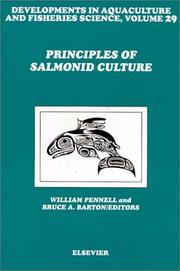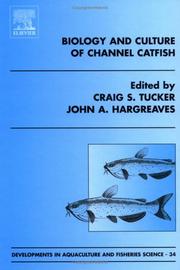| Listing 1 - 10 of 69 | << page >> |
Sort by
|
Book
ISBN: 0080249205 0080249191 9780080249193 Year: 1985 Publisher: Oxford Pergamon
Abstract | Keywords | Export | Availability | Bookmark
 Loading...
Loading...Choose an application
- Reference Manager
- EndNote
- RefWorks (Direct export to RefWorks)
Fish culture --- Pisciculture --- Fish-culture --- #WDIR:wbse --- Artificial propagation of fishes --- Culture, Fish --- Farming, Fish --- Fish aquaculture --- Fish farming --- Fish husbandry --- Fish rearing --- Fishes --- Rearing of fishes --- Animal culture --- Aquaculture --- Culture --- Farming --- Husbandry --- Rearing
Book
ISBN: 9250009100 9789250009100 Year: 1981 Volume: 19 Publisher: Rome FAO
Abstract | Keywords | Export | Availability | Bookmark
 Loading...
Loading...Choose an application
- Reference Manager
- EndNote
- RefWorks (Direct export to RefWorks)
Fish culture --- Terminology --- Fish-culture --- -#ABIB:FAOdeposit --- Artificial propagation of fishes --- Culture, Fish --- Farming, Fish --- Fish aquaculture --- Fish farming --- Fish husbandry --- Fish rearing --- Fishes --- Pisciculture --- Rearing of fishes --- Animal culture --- Aquaculture --- Culture --- Farming --- Husbandry --- Rearing --- #ABIB:FAOdeposit --- Fish culture - Terminology
Book
ISBN: 0444425276 9780444425270 Year: 1985 Volume: 15 Publisher: Amsterdam Elsevier
Abstract | Keywords | Export | Availability | Bookmark
 Loading...
Loading...Choose an application
- Reference Manager
- EndNote
- RefWorks (Direct export to RefWorks)
Fish-culture --- Channel catfish --- Artificial propagation of fishes --- Culture, Fish --- Farming, Fish --- Fish aquaculture --- Fish farming --- Fish husbandry --- Fish rearing --- Fishes --- Pisciculture --- Rearing of fishes --- Animal culture --- Aquaculture --- Channel cat (Fish) --- Ictalurus punctatus --- Ictalurus --- Culture --- Farming --- Husbandry --- Rearing
Book
ISBN: 9789264070141 Year: 1998 Publisher: Paris : OECD Publishing,
Abstract | Keywords | Export | Availability | Bookmark
 Loading...
Loading...Choose an application
- Reference Manager
- EndNote
- RefWorks (Direct export to RefWorks)
In this Short-term Toxicity Test on Fish Embryo and Sac-Fry Stages, the life stages from the newly fertilized egg to the end of the sac-fry stage are exposed. The embryo and sac-fry stages of fish are exposed to five concentrations of the test substance dissolved in water. A choice, depending on the nature of the test substance, is possible between a semi-static and a flow-through procedure. The test starts with placing at least 30 fertilised eggs divided equally between at least three replicate test chambers per concentration, and is terminated just before the yolk-sac of any larvae in any of the test chambers has been completely absorbed or before mortalities by starvation start in controls. Lethal and sub-lethal effects are assessed and compared with control values to determine the lowest observed effect concentration and hence the no observed effect concentration. Alternatively, they may be analysed using a regression model in order to estimate the concentration that would cause a given percentage effect. The study report should include: the daily counting of the offspring, the daily recording of the parent mortality, the weekly measurement of oxygen concentration, temperature, and pH values; and the determination of the concentrations of test substance. It should also include the observations of abnormal appearance, abnormal behaviour, hatching and survival...
Fish culture --- Artificial propagation of fishes --- Culture, Fish --- Farming, Fish --- Fish aquaculture --- Fish farming --- Fish husbandry --- Fish rearing --- Fishes --- Pisciculture --- Rearing of fishes --- Animal culture --- Aquaculture --- Culture --- Farming --- Husbandry --- Rearing
Periodical
Abstract | Keywords | Export | Availability | Bookmark
 Loading...
Loading...Choose an application
- Reference Manager
- EndNote
- RefWorks (Direct export to RefWorks)
Fish culture --- Fishes --- Fish --- Pisces --- Aquatic animals --- Vertebrates --- Fisheries --- Fishing --- Ichthyology --- Artificial propagation of fishes --- Culture, Fish --- Farming, Fish --- Fish aquaculture --- Fish farming --- Fish husbandry --- Fish rearing --- Pisciculture --- Rearing of fishes --- Animal culture --- Aquaculture --- Physiology --- Culture --- Farming --- Husbandry --- Rearing
Book
ISBN: 0128016906 9780128016909 9780128014189 0128014180 Year: 2016 Publisher: London Academic Press
Abstract | Keywords | Export | Availability | Bookmark
 Loading...
Loading...Choose an application
- Reference Manager
- EndNote
- RefWorks (Direct export to RefWorks)
Fish culture. --- Fishes --- Genetics. --- Fish genetics --- Artificial propagation of fishes --- Culture, Fish --- Farming, Fish --- Fish aquaculture --- Fish farming --- Fish husbandry --- Fish rearing --- Pisciculture --- Rearing of fishes --- Animal culture --- Aquaculture --- Culture --- Farming --- Husbandry --- Rearing

ISBN: 9780444821522 044482152X 9780080539669 0080539661 9786611311575 128131157X Year: 1996 Volume: 29 Publisher: Amsterdam New York Elsevier
Abstract | Keywords | Export | Availability | Bookmark
 Loading...
Loading...Choose an application
- Reference Manager
- EndNote
- RefWorks (Direct export to RefWorks)
As salmonids have been reared for more than a century in many countries, one might expect that principles are well established and provide a solid foundation for salmonid aquaculture. Indeed, some of the methods used today in salmonid rearing are nearly identical to those employed one hundred years ago. Areas of salmonid research today include nutrition, smolt and stress physiology, genetics and biotechnology. The purpose of this book is to provide a useful synthesis of the biology and culture of salmonid fishes. The important practices in salmonid culture as well as the theory behind them i
Salmon farming --- Salmon. --- Fish culture. --- Artificial propagation of fishes --- Culture, Fish --- Farming, Fish --- Fish aquaculture --- Fish farming --- Fish husbandry --- Fish rearing --- Fishes --- Pisciculture --- Rearing of fishes --- Animal culture --- Aquaculture --- Salmons --- Salmonidae --- Culture --- Farming --- Husbandry --- Rearing

ISBN: 9780444505767 0444505768 9780080472201 0080472206 9786610967117 1280967110 Year: 2004 Publisher: Amsterdam London Elsevier
Abstract | Keywords | Export | Availability | Bookmark
 Loading...
Loading...Choose an application
- Reference Manager
- EndNote
- RefWorks (Direct export to RefWorks)
The history of channel catfish farming in the United States serves as a model for the development of pond-based aquaculture industries worldwide. Channel catfish farming is the largest and economically most important aquaculture industry in the United States. In 2003, over 300,000 metric tons (662 million pounds) of channel catfish were processed, representing about half the total United States aquaculture production. Demand for farm-raised catfish is strong, with record processing years in 2002 and 2003.
Channel catfish. --- Fish culture. --- Artificial propagation of fishes --- Culture, Fish --- Farming, Fish --- Fish aquaculture --- Fish farming --- Fish husbandry --- Fish rearing --- Fishes --- Pisciculture --- Rearing of fishes --- Animal culture --- Aquaculture --- Channel cat (Fish) --- Ictalurus punctatus --- Ictalurus --- Culture --- Farming --- Husbandry --- Rearing
Book
ISBN: 9251041393 9789251041390 Year: 1998 Volume: 32 Publisher: Rome : Food and Agriculture Organization of the United Nations,
Abstract | Keywords | Export | Availability | Bookmark
 Loading...
Loading...Choose an application
- Reference Manager
- EndNote
- RefWorks (Direct export to RefWorks)
Fish-culture --- Fish culture --- 639.3 --- -#ABIB:FAOdeposit --- Artificial propagation of fishes --- Culture, Fish --- Farming, Fish --- Fish aquaculture --- Fish farming --- Fish husbandry --- Fish rearing --- Fishes --- Pisciculture --- Rearing of fishes --- Animal culture --- Aquaculture --- Fish breeding. Pisciculture. Aquaculture --- Culture --- Farming --- Husbandry --- Rearing --- 639.3 Fish breeding. Pisciculture. Aquaculture --- #ABIB:FAOdeposit --- Fish-culture - Africa
Book
ISBN: 2040054375 9782040054373 2040109285 9782040109288 Year: 1976 Publisher: Paris : Gauthier-Villars,
Abstract | Keywords | Export | Availability | Bookmark
 Loading...
Loading...Choose an application
- Reference Manager
- EndNote
- RefWorks (Direct export to RefWorks)
Fishery management --- Fish-culture --- Fish culture --- Artificial propagation of fishes --- Culture, Fish --- Farming, Fish --- Fish aquaculture --- Fish farming --- Fish husbandry --- Fish rearing --- Fishes --- Pisciculture --- Rearing of fishes --- Animal culture --- Aquaculture --- Fish management --- Fisheries --- Fisheries management --- Fishery resources --- Aquatic resources --- Wildlife management --- Fish counting towers --- Overfishing --- Culture --- Farming --- Husbandry --- Rearing --- Management --- Freshwater --- Aquatic communities --- ecosystems --- Fish culture. --- Amenagement piscicole
| Listing 1 - 10 of 69 | << page >> |
Sort by
|

 Search
Search Feedback
Feedback About UniCat
About UniCat  Help
Help News
News